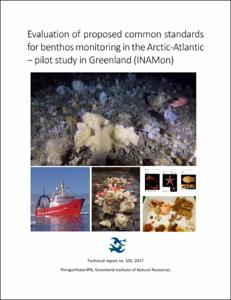| dc.contributor.author | Blicher, Martin E. | |
| dc.contributor.author | Hammeken Arboe, Nanette | |
| dc.coverage.spatial | Greenland waters | en_US |
| dc.date.accessioned | 2022-02-15T21:21:37Z | |
| dc.date.available | 2022-02-15T21:21:37Z | |
| dc.date.issued | 2017 | |
| dc.identifier.citation | Blicher, M.E. and Hammeken Arboe, N. (2017) Evaluation of common standards for benthos monitoring in the Arctic-Atlantic – pilot study in Greenland (INAMon). Nauk, Greenland, Greenland Institute of Natural Resources, 31pp + supplementary appendix. (Greenland Institute of Natural Resources Technical Report nr. 105). DOI: http://dx.doi.org/10.25607/OBP-1715 | en_US |
| dc.identifier.isbn | 87-91214-82-3 | |
| dc.identifier.uri | https://repository.oceanbestpractices.org/handle/11329/1864 | |
| dc.identifier.uri | http://dx.doi.org/10.25607/OBP-1715 | |
| dc.description.abstract | In 2015, the Greenland Institute of Natural Resources realized a concept for long-term and large-scale monitoring of marine bottom-living invertebrate fauna (benthos) in the Arctic-Atlantic as part of the international research project, Initiating North-Atlantic Benthos Monitoring (INAMon) (Blicher et al. 2015). The initiative was, first of all, motivated by a large gap in knowledge about the benthic ecosystem in the Arctic in general, and about the influence of climate, trawling, oil exploitation and other potential anthropogenic and natural drivers. However, the high cost of benthos studies using conventional methods, and limited financial, logistic and scientific capacities have prevented most Arctic nations to address these gaps in knowledge on the relevant geographical and temporal scales. Therefore, a main goal of INAMon was to develop a cost-efficient approach to benthos monitoring, realistic to be implemented across the Arctic. A “trawl bycatch-program” was integrated on national fisheries research surveys in Greenland waters. Besides producing high-quality information about focal components of the benthic community in Greenland, the surveys also acted as a platform for knowledge exchange between Arctic benthos specialists in order to ensure methodological consistency and data comparability across nations.
During 2015 and 2016 we have reached more than 1100 sampling stations in Greenland, covering a depth range from 40 to 1500 meters, and a latitudinal range from 60 to 76°N. We have documented a total of >900 different benthos species/taxa and a wide range of communities. We have significantly increased the knowledge about the occurrence of sponge grounds and dense concentrations of cold-water corals, which are regarded indicators of Vulnerable Marine Ecosystem (VME) habitats. In this report, we show examples of our results, and evaluate the monitoring concept in relation to the identified needs. | en_US |
| dc.language.iso | en | en_US |
| dc.publisher | Pinngortitaleriffik, Greenland Institute of Natural Resources | en_US |
| dc.relation.ispartofseries | Greenland Institute of Natural Resources Technical Report;105 | |
| dc.title | Evaluation of proposed common standards for benthos monitoring in the Arctic-Atlantic – pilot study in Greenland (INAMon). | en_US |
| dc.type | Report | en_US |
| dc.description.status | Published | en_US |
| dc.format.pages | 31pp. & Appendices | en_US |
| dc.description.refereed | Refereed | en_US |
| dc.publisher.place | Nuuk, Greenland | en_US |
| dc.subject.parameterDiscipline | Biota abundance, biomass and diversity | en_US |
| dc.description.currentstatus | Current | en_US |
| dc.description.sdg | 14.a | en_US |
| dc.description.eov | N/A | en_US |
| dc.description.adoption | National | en_US |
| dc.description.methodologyType | Method | en_US |
| dc.description.methodologyType | Reports with methodological relevance | en_US |
| obps.contact.contactemail | info@natur.gl | |
| obps.resourceurl.publisher | www.natur.gl | |
 Repository of community practices in Ocean Research, Applications and Data/Information Management
Repository of community practices in Ocean Research, Applications and Data/Information Management
